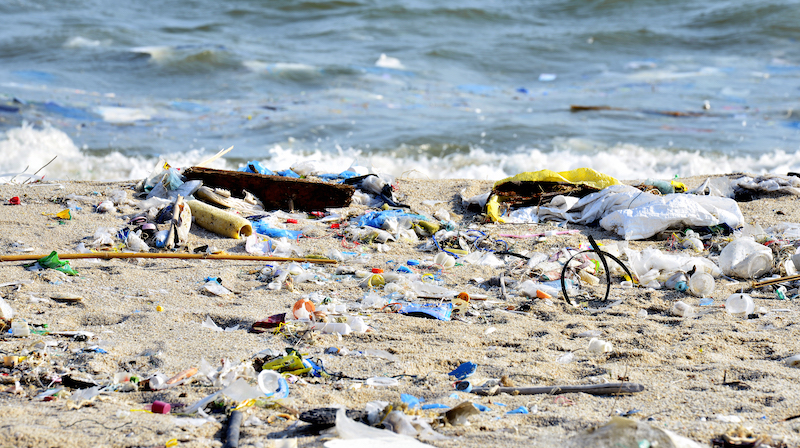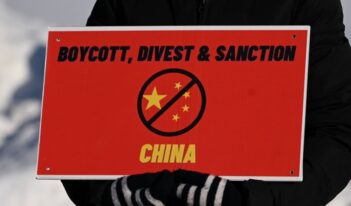
Despite state and local action, more effective reduction of single-use plastics must come from Congress.
Plastic pollution appears to be arising ever more frequently in the news. Companies like Starbucks have announced voluntary steps to rid their stores of plastic straws. China is wielding its “National Sword” policy, which places restrictions on the amount and type of plastic waste it will accept from abroad, which has prompted cries for improvements to recycling technologies and infrastructure in the United States. A young entrepreneur designed a floating boom intended to rake up debris from the Great Pacific Garbage Patch—a large accumulation of plastic debris and other waste floating in the Pacific Ocean—but it returned to port in pieces in early January, battered by unrelenting wind and waves, indicating the challenges of ocean cleanup.
All this attention is warranted: There are trillions of pieces of plastic debris in the oceans, and over 700 species—including 84 percent of sea turtle species—have been impacted. Marine wildlife can mistake plastic debris for food, and necropsies of birds, sea turtles, and whales have shown stomachs full with plastic. Plastic pollution affects humans as well: Plastic has made its way into our food, our table salt, and our drinking water. Chemicals used in plastic, like bisphenol A, have been linked to cancer, endocrine disruption, and adverse developmental consequences in children.
Comprehensive federal legislation to address single-use plastics does not yet exist in the United States. Instead, the conversation has focused on encouraging foreign governments to control plastic waste, making improvements to recycling and waste management infrastructure, and promoting voluntary steps industries can take to improve plastic products and reduce waste.
Missing from that conversation is a critical piece of the puzzle: reducing consumption of single-use plastic at the source to limit the amount of plastic trash Americans generate. To reduce single-use plastics more effectively, Congress must step in and regulate through source control.
Source control is important for a number of reasons. Less than 10 percent of the world’s plastic waste is recycled, and many kinds of single-use plastic waste, like thin plastic bags and Styrofoam, cannot be recycled entirely.
Voluntary steps to address plastic pollution can be positive but are not enforceable. Only regulation can create a level playing field that applies the same standards to all businesses. And plastic production and breakdown is linked to climate change. Plastic is a petroleum-based product, and, by the plastic industry’s own assessment, plastic production is expected to increase significantly over the next few decades. This means the plastic industry’s share of greenhouse gas emissions will increase as well. Some estimates project greenhouse gas emissions from the petrochemical sector will increase 30 percent by 2050. Studies are now showing that plastic releases greenhouse gases as it breaks down, too.
In the United States, hundreds of local governments and a handful of states have taken steps to stem the tide of plastic entering our environment through source control measures. Over 340 municipalities have laws that ban single-use plastic carryout bags, place a charge on carryout bags, or combine both strategies. Some cities and states are now taking action to ban other single-use items, like straws, foodware, and to-go cups.
But bans and fees are just one part of a solution and must be implemented carefully. For example, an outright ban on single-use plastic bags alone could drive consumers to shift to free single-use paper bags, which come with their own set of environmental consequences, making imposition of a fee on all single-use carryout bags an important part of bag use reduction efforts. Indeed, fees have been incredibly successful in shifting consumer behavior. They have prompted as high as an 85 percent reduction in point-of-sale consumption of single-use bags. Beyond bans and fees, consumer education and extended producer responsibility programs can also play an important role in source control efforts, raising awareness and placing responsibility on manufacturers to manage their products at end of life.
A holistic approach to plastic pollution at the national level could employ a number of strategies to tackle the issue, including source control to reduce consumer use of single-use plastic items, improvement of recycling and waste management infrastructure, and research and development. It would also provide a national framework to reduce single-use plastic waste. Despite their effectiveness, some local actions are under threat by claims of state-level preemption. Comprehensive federal legislation to address single-use plastics could resolve that issue.
The United States would not be alone in taking this kind of step. At the end of last year, the European Commission announced an agreement, confirmed last month, between the European Parliament and the Council of the European Union to reduce single-use plastic waste. The new European Union (EU) directive targets the 10 plastic products most commonly found on European beaches, as well as abandoned fishing gear. It employs a suite of strategies: bans on single-use items for which affordable alternatives are available, like cutlery, straws, and stirrers; consumption reduction and waste collection targets for other single-use items like food containers, cups, and bottles; incentives for manufacturers to develop lower-polluting versions of their products; awareness-raising campaigns targeting consumers; and producer responsibility for costs of waste management and awareness-raising. The Commission reportedly estimates the new policy will avoid €22 billion in environmental damages by 2030 and will save consumers about €6.5 billion.
Plastic pollution is a serious problem and requires a thoughtful, multi-pronged approach. The EU’s strategy provides an example of just such a comprehensive policy—one Congress could draw on in developing much-needed federal legislation in the United States.




